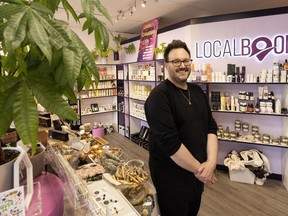Experts say if B.C. really wants to soften the blow of a possible trade war, it needs to make it easier for locals to buy local products.

If it was summer, Lenore Newman might not have found Premier David Eby’s recent shopping advice so jarring.
On Tuesday, Eby asked British Columbians to buy products made in Canada as a way to counter expected U.S. tariffs.
“The premier is exactly right that we need to focus on domestic supply,” said Newman, a food security professor at the University of the Fraser Valley. “But the problem is it’s winter and our food processing industry is in shambles.”
Newman wants to see the government loosen regulations to allow food processing on farmland, so Canada isn’t sending raw ingredients to the U.S. only to have consumers buy them back in the form of finished products. That processing should be happening in B.C., she said, which would increase the availability of local food products for consumers at home, while also opening new avenues for export to countries other than the U.S.
She said the province needs to do more than exhort British Columbians to “buy local.” If it really wants to soften the blow of a possible trade war, it needs to make it easier for them to do so.
On Tuesday, Eby asked people to think carefully about spending money to support a country that wants to do Canada economic harm.
“I hope … when you’re at the grocery store and you have a chance to buy a product, right now you’re looking carefully at the labels to support Canadian jobs and to support Canada at this critical time,” he said.
Werner Antweiler, an economics professor at the University of B.C., said he felt the premier’s comments were meant to be “symbolic” and signal unity not only among consumers, but also among Canada’s provinces.
“I don’t think there’s an expectation that (consumer behaviour) will have a significant impact,” he said.
The economist said that unless a product is closely associated with its place of origin, such as California wine or Florida oranges, most consumers are going to struggle to determine if a can of soup on the grocery store shelf is made from B.C. ingredients. Large buyers, such as provincial liquor boards, may be able to send a message by refusing to stock American products, but in some cases, foreign goods may be better or cheaper.
He said provincial unity will be key so that Canada can “use all the tools” to make the case against tariffs.
Newman was also hesitant about the possible impact of individual consumer behaviour.
“To be honest, everyone has to realize the game has changed,” she said. “We’ve lived through 20 years of really good times, and this is a different global scenario. It will be tough.”
Her advice to consumers: Buckle up. Her advice to the provincial government: Move fast.
Newman said the Buy B.C. program, a marketing tool to help consumers identify products that are grown, raised or made in B.C., is a decent start, but “our problem is the government is too focused on the growing side.”
“Field to table — that’s what we need to think about now,” she said.
Coffee roaster Rob Comeau said he is grateful for the Buy B.C. program for help raising the profile of his coffee, but many B.C.-made products face a tough road. It’s difficult — and expensive — to get a product into a large store, with some charging for shelf space. In his sector, there is also competition from larger roasters who supply coffee shops with equipment in order to sell their product, something he can’t afford to do.
“You’re putting your money back into your own community,” he said. “As an educator, I see that full cycle. The tax revenue goes back into our schools, into our kids here in B.C.”
At his shop in Vancouver, Steven Kieboom also sees the impact committed and informed consumers can make.
“People often don’t know these products exist, because they don’t get the shelf space,” he said.
Kieboom said his company is somewhat insulated from tariffs, but he is still worried about the trickle-down effect of a possible trade war if people have less money to spend.

B.C. Agriculture Minister Lana Popham said the Buy B.C. label and website can help consumers support B.C. products. She had a smoothie for breakfast made from frozen B.C. blueberries. Local potatoes, carrots, cabbage and mushrooms are still plentiful in January. Dairy products, chicken and eggs available in B.C. grocery stores are almost exclusively produced in Canada.
“This is a big moment for us,” she said. “We need to stick together.”
How to read labels to tell if products are grown, raised or made in B.C.
“Local food” is defined as food produced in the province or territory in which it is sold, or food sold across provincial borders within 50 km of the originating province or territory.
A food product may use the claim “Product of Canada” when all or virtually all major ingredients, processing, and labour used to make the food product are Canadian. Low levels of food grown elsewhere, such as vanilla, certain spices or sugar, may still be present, but usually in quantities of less than two per cent of the product.
A “Made in Canada” claim with a qualifying statement can be used on a food product when the last substantial transformation of the product occurred in Canada, even if some ingredients are from other countries.
Qualifying statements include “Made in Canada from imported ingredients” or “Made in Canada from domestic and imported ingredients.”
For example, a cookie manufactured in Canada using Canadian flour, oatmeal and shortening and imported sugar may be labelled or advertised with the claim “Made in Canada from domestic and imported ingredients.”